
Circuitry Unit: Lesson 2 Conductors and Insulators
The project requires students to act as mechanical and electrical engineers who are tasked with planning, designing, and testing a new toy invention. This toy must have functioning lights, and teams must work together to find safe materials that allow electricity to flow through the toy while keeping the child safe. They must use a conductive material to surround the electrical components and prevent electrical energy from harming the child.
The teams will use the Steve Spangler Science Energy Stick to identify and list insulators and conductors to accomplish this. They will draw a diagram of their toy, which must have one functioning light, and identify and label the possible conductive materials that can be used inside the toy to ensure the light will work. In addition, they must identify insulating materials that can be used outside of the toy to stop the flow of an electrical current.
The teams are only allowed to list the materials tested during the lesson.
The materials they can use include the Steve Spangler Science Energy Stick Conductor (1 conductor per team) and various objects made of different materials such as metal, plastic, rubber, glass, and paper. They will need a notebook or paper to record observations and a pen or pencil to make notes.
Lesson Grade Level
4th GradeLesson Plan Link/URL
https://docs.google.com/presentation/d/1skqmwzR6nYzDhtyNL8SB6C0XjRFD42nIEAH7QCf…Related Content

In this lesson plan, students will be able to build a simple electric motor and study how simple changes affect the motor's rotation. They will learn how energy comes in many forms, and how electric


A Shocking Dystopia: STEM Adventures in The City of Ember Part 1 of 4: Blackout! Community Circuits
This lesson is PART 1 of a four-lesson unit, which focuses on futures thinking, the phenomenon of electricity, closed-system agriculture, and water as a renewable energy resource. “The City of Ember”